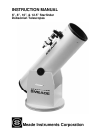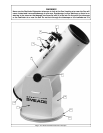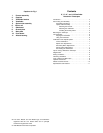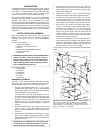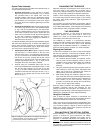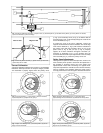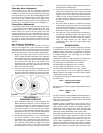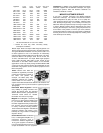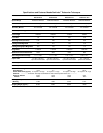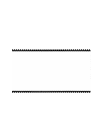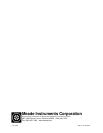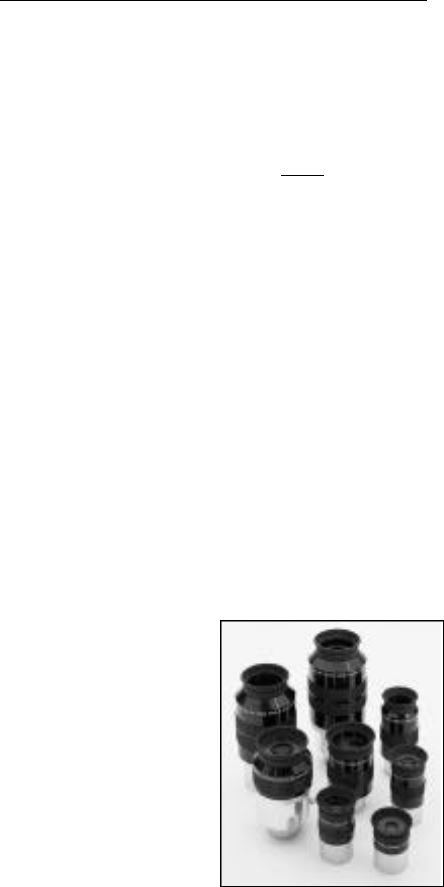
- 8 -
detail than a dimmer, poorly resolved, larger image.
Because of certain characteristics of the human eye (in
p a r t i c u l a r, eye pupil diameter) and because of optical
considerations inherent in the design of the telescope, there
exist minimum practical power levels also. Generally speaking
the lowest usable power is approximately 4X per inch of
telescope aperture.
SEEING CONDITIONS
Even in normal city conditions, with all of the related air and
light pollution, there are many interesting celestial objects to
observe. But, to be sure, there is no substitute for the clear,
dark, steady skies generally found only away from urban
environments, or on mountaintops: objects previously viewed
only in the city take on added detail or are seen in wider
extension, or even become visible at all for the first time.
The amateur astronomer is faced typically with two broadly
defined problems when viewing astronomical objects through
the Earth’s atmosphere: first is the clarity, or transparency, of
the air, and secondly the steadiness of the air. This latter
characteristic is often referred to as the quality of “seeing.”
Amateur astronomers talk almost constantly about the “seeing
conditions,” since, perhaps ironically, even the clearest, darkest
skies may be almost worthless for serious observations if the
air is not steady. This steadiness of the atmosphere is most
readily gauged by observing the “twinkling” of the stars: rapid
twinkling implies air motion in the Earth’s atmosphere, and
under these conditions, resolution of fine detail (on the surface
of Jupiter, for instance) will generally be limited. When the air is
steady, stars appear to the naked eye as untwinkling points of
unchanging brightness, and it is in such a situation that the full
potential of the telescope may be realized: higher powers may
be used to advantage, closer double stars resolved as distinct
points, and fine detail observed on the Moon and planets.
OBSERVING GUIDELINES
Several basic guidelines should be followed for best results in
using your telescope:
1. Try not to touch the eyepiece while observing. Any
vibrations resulting from such contact will immediately
cause the image to move.
2. Allow your eyes to become “dark-adapted” prior to making
serious observations. Night adaptation generally requires
about 10-15 minutes for most people.
3. Let the telescope “cool down” to the outside
environmental temperature before making observations.
Differences in temperature between a warm house and
the cold outside air require about 30 minutes for the
telescope’s optics to regain their true correct figures.
During this period the telescope will not perform well.
4. If you wear glasses and do not suffer from astigmatism,
take your glasses off when observing through the
telescope. You can re-focus the image to suit your own
eyes. Observers with astigmatism, however, should keep
their glasses on, especially with lower powered
eyepieces. The effects of astigmatism are reduced with
higher power eyepieces, so eyeglasses may be removed
to improve eye relief.
5. Avoid setting up the telescope inside a room and
observing through an open window (or, worse yet, through
a closed window!). The air currents caused by
inside/outside temperature differences will make quality
observing impossible.
6. Perhaps most important of all, avoid “overpowering” your
telescope. The maximum usable magnification at any
given time is governed by the seeing conditions. If the
telescopic image starts to become fuzzy as you increase
in power, drop down to a reduced magnification. A smaller,
but brighter and sharper, image is far more preferable to a
larger, but fuzzy, indistinct one.
As you use your telescope more and more, you will find that
you are seeing more and finer detail: observing through a
large-aperture telescope is an acquired skill. Celestial
observing will become increasingly rewarding as your eye
becomes better trained to the detection of subtle nuances of
resolution.
CARE OF OPTICS AND MAIN TUBE
With the reasonable care due any fine instrument, your Meade
telescope will last a lifetime. If the eyepieces become dirty, try
cleaning them with a camel’s hair brush or compressed air. If
you must wipe the surface of the lenses, do so gently with a soft
cloth so as not to scratch the protective coatings.
The aluminum coating on the primary and secondary mirrors
may last more than ten years without significant deterioration.
(The coatings will last a shorter period if regularly exposed to
salty or polluted air.) Minor blemishes, scratches, or streaks will
NOT impair the telescope’s performance. Re-coating, when
necessary, is relatively inexpensive. Contact your local Meade
dealer for information on mirror re-coating services.
The most common error is to clean the optics too often. If
cleaning does become necessary, clean as follows:
1. Using distilled water and cotton, gently swab the surface
of the mirror to remove any dust or dirt. Use the cotton to
make one pass over the mirror and then use new cotton.
This will keep the dirt previously removed from contacting
the mirror surface and scratching the coatings.
2. Dip a wad of cotton in a mild detergent solution (1/2
teaspoon to 1 pint of water) and gently swab the entire
surface. This will remove any oily deposits or fingerprints.
3. Swab the entire surface. Do not turn over the cotton wads
or dissolved skin oils may deposit on the mirror’s surface.
Immediately take a dry swab and continue wiping the
entire surface gently. Keep changing wads until the mirror
surface is completely dry and free of streaks.
When cleaning the outside of the Starfinder optical tube (1),
use a mild detergent, (Pine-Sol, Formula 409, Fantastic, or oil
soap). Oil soap is preferred as it also acts as a preservative for
the paint. Solvent or alcohol-based cleaning solutions will
diminish the original luster of the paint.
OPTIONAL ACCESSORIES
A wide assortment of professional Meade accessories is
available for the Starfinder telescopes.
Dust Covers: Snug-fitting vinyl dust covers protect optics from
outside dust during storage of the telescope.
Eyepieces: Many additional eyepieces are available for higher
and lower magnifications. All Meade Starfinder Equatorial
telescopes accept standard 1.25" O.D. eyepieces as well as 2"
O.D. eyepieces.
Meade Super Plössl (SP),
Super Wide Angle (SWA ) ,
and Ultra Wide Angle (UWA)
Eyepieces in the standard
American-size (1.25") barrel
diameter permit a wide range
of magnifying powers with the
telescope. Powers obtained
with each eyepiece are as
follows:



